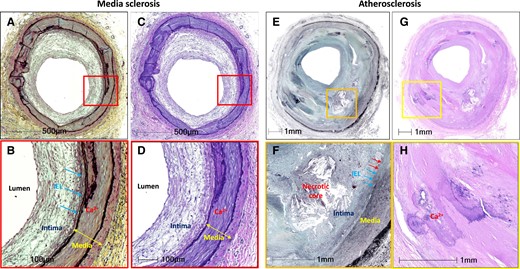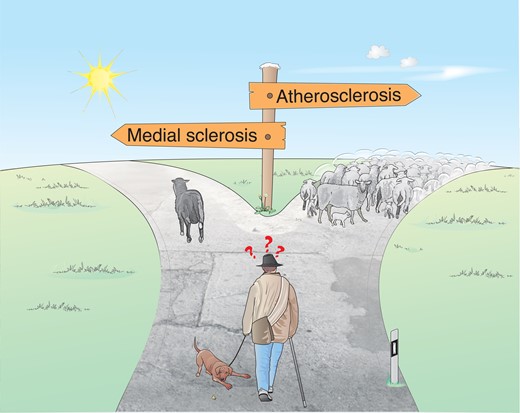-
PDF
- Split View
-
Views
-
Cite
Cite
Peter Lanzer, Yu Sato, Renu Virmani, A rose by any other name would smell as sweet; does nomenclature matter?, European Heart Journal, Volume 43, Issue 30, 7 August 2022, Pages 2824–2826, https://doi.org/10.1093/eurheartj/ehac292
Close - Share Icon Share
Do you say arteriosclerosis or do you call atherosclerosis?1,2 Classically three lesions have been described under arteriosclerosis:1 atherosclerosis,2 Mönckeberg’s medial sclerosis, and arteriolosclerosis.3Arteriosclerosis is a Greek term meaning ‘hardening of the arteries.’ On the other hand, the term atherosclerosis is etymologically based on the Greek terms athero (gruel or paste) and suffix -oma (growth or tumour) together indicating the formation of ‘atheroma’. In scientific literature arteriosclerosis and atherosclerosis have been accepted as synonyms each emphasizing different aspect of the disease. Medial sclerosis4 denotes calcification of the internal elastic layer and of the media of the artery wall.
Recognition of the importance of lipoprotein metabolism and inflammation in atherogenesis represents one of the most significant accomplishments in recent history of cardiovascular diseases.5 Given the overriding importance of atherosclerosis and its thrombotic complications dominating coronary and non-coronary artery disease terminology the use of arteriosclerosis as a synonym is indeed inappropriate. Furthermore, it is important to separate arteriolosclerosis from atherosclerosis as the former does not involve cholesterol metabolism, denoting instead a thickening of the small artery wall characterized by one or more layers of intimal fibromuscular tissue with or without hyaline deposition frequently associated with hypertension and diabetes. So, terminology does matter!
While the understanding of pathogenesis of medial sclerosis, disease of the intima, is limited,6 the distinct spectrum of risk factors,7 the clearly singular histological signature (Figure 1) and the importance in the development of critical limb threatening ischaemia8 justify independent considerations from atherosclerosis. Nevertheless, the manuscript on medial sclerosis submitted to a respected journal already several months past submission remains in limbo following a series of controversial reviews, still awaiting the decision of the Editorial Board (personal communication). Owing to the overriding prestige of arteriosclerosis-atherosclerosis and lack of established clinical expertise concerning medial sclerosis the editors encounter difficulties finding competent reviewers while reviewers frequently tussle with the data. Caught in this Catch 22 (Heller J. Catch 22, numerous publishers and editions) lengthy review process and frequent rejections are commonplace representing ongoing dilemma (Figure 2). Are medical misnomers, the terms for diseases not reflecting their pathology, exceptional rarity?

Comparison of media sclerosis and atherosclerosis. Low-power (A and C) and high-power (B and D) images of popliteal artery showing Monkeberg's medial sclerosis. Note presence of Grade IV (i.e., circumferential) medial calcification. Intimal thickening is seen (B and D) without atherosclerosis. The internal elastic lamina (IEL) is intact as demonstrated in B (blue arrows). Low-power (E and G) and high-power (F and H) images are the superficial femoral artery showing atherosclerosis. A necrotic core and IEL disruption is observed (F, red arrows) (blue arrows show intact IEL). Fragments of calcification (Ca++) are also present in the intima (H). Images A, B, E, and F are stained with Movat pentachrome. Images C, D, G, and H are stained with haematoxylin and eosin.

Editors’ and peer reviewers’ dilemma. Medial sclerosis and arteriosclerosis-atherosclerosis are two different paths ahead. As aptly stated by Robert Grubbs: ‘When you reach a fork in the road – take it!’ (quoted in Nature 24.2.2022).
In medical scientific literature semantic inaccuracies and misnomers are nothing new. In 1839 Doctor William Farr, Epidemiologist in London, stated that ‘Each disease has, in many instances, been denoted by three or four terms, and each term has been applied to as many different diseases; vague inconvenient names have been employed, or complications have been registered instead of primary diseases. The nomenclature is of as much importance in this department of inquiry as weights and measures in the physical sciences, and should be settled without delay.’9 While important progress such as the establishment of the International Classification of Diseases has been achieved controversies regarding nomenclature remain. The uncertain aetiology and evolving understanding of molecular and cellular pathogenesis of diseases is but one of several possible explanations.
In 1970 the social psychologist Irving L. Janis, research psychologist at Yale, analysed president’s J.F. Kennedy’s remark ‘How could we have been so stupid?’ addressing those of his staff involved in the decision concerning the botched Bay of Pigs invasion of Cuba on April 17, 1961. One of the conclusions Janis drew was the importance of groupthink. Groupthink, Janis wrote ‘refers to deterioration in mental efficiency, reality testing and moral judgments as a result of group pressures’.10 Janis pointed out that in dealing with the ensuing Cuban missile crises in October 1962 the essentially identical group of decision makers have learned their lesson. Later, Groupthink has become a ‘Big Thing’ in cognitive and social psychology recognized as a major threat to knowledge-based decision making. The insights gained from Janis’s research and studies of biases have underlined the importance of human factors in decisions including scientific publishing.
Doctor Farr’s perception still holds. Based on the current scientific and clinical evidence medial sclerosis should be considered a disease sui generis independent of arteriosclerosis-atherosclerosis justifying independent scientific expertise and clinical considerations. Name recognition may represent the first step towards refocusing research efforts, simplifying access to publishing for the researchers and alleviating editors’ and peers’ dilemmas in judging the submissions; despite the fact that the final verdict must await the discovery of the medial sclerosis molecular pathogenesis.
Acknowledgments
P.L. wishes to thank Professor Thomas F. Lüscher for his expert commentary on the first draft of the manuscript.
References
Author notes
Shakespeare W. Romeo and Juliet, Act 2, Scene 2.



